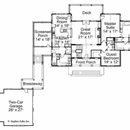Which foundation strategy would you choose?
I’m in the planning stage for a one-story house with approximately 1,700 square feet. I’d prefer to put it on a raised slab but that might be difficult since the site (topo attached) slopes quite a bit. I think I can make it work if the house is located close to the street. The minimum setback is 15 feet since some of the lots are veritable cliffs.
A crawlspace would be easy, I think. But I’m not wild about the costs of having to condition one. It also would be easy to push the house (floor plan) attached) further back and build a full basement, but I’m trying to keep things affordable and going for a basement on a previous home caused lots of budget creep. (And how much space do two people really need?)
(FWIW. The garage will need to be moved to fit the lot.)
So what would the GBA community advise?
GBA Detail Library
A collection of one thousand construction details organized by climate and house part











Replies
Lots of people like walkouts if you can make that fit. I personally prefer to have a basement because it is a good place to put mechanicals, and it's always nice to have some extra storage space. It's often not hugely more expensive to put in a basement compared to just a crawl space.
Note that you could do a basement only under part of the house to potentially save a little money. Make it big enough to comfortably house your mechanicals (furnace, water heater, etc.), and any extra space for storage you might want.
Bill
How were you planning on running the HVAC? Looks like most rooms have vaulted ceilings. If you were debating between basement vs crawlspace...there really isn’t much of a savings with a crawl space (in my experience). From a builders perspective an unfinished basement is a somewhat easy up sell. Biggest thing if you go with a basement is the fire rating at the floor level and the location of your thermal envelope (at floor level or basement walls). If you include the basement inside your thermal envelope that will help with the blower door score. Those are just some thoughts.
Jared.
Hi Bill,
I heard that basement argument on my last house, and it turned out to entail a lot of "might-as-wells" along the way. In the end, it probably added lots [deleted dollar amount since costs on this project were a blackhole] to the budget. I'm concerned something similar will happen even if I do the minimum in terms of insulating, electrical, plumbing, wiring, windows, stairs, and so forth. It's 1,700 square feet after all. A partial basement plus slab might be better from a cost and utility standpoint.
Jared,
I haven't finalized the HVAC but am leaning toward using different types of recessed heads or closet-friendly air handlers for heating and cooling. (I'm lucky to have a couple of great HVAC designers in my area.) So no ducts, or just short ducts.
There will be some areas with flat ceilings where I could put equipment, but I hate having to go through a hatch to change filters. So I would reconfigure the space a bit to find space for the water heater, ventilation system, and HVAC. But it will require some creative thinking to make things work.
Everything is on the table, but I would prefer to keep the foundation simple and affordable.
Thank you both for your input.
Steve- with all due respect, you really need to flush out that response. Ive built four houses for myself and yes a full basement ESPECially if Done properly will add a not inconsiderable expense (ie excavation, dirt removal, crushed stone backfill exterior and interior drains (including radon in my area !), and i find that when you make it clear you will insist the concrete pour is of adequate psi, they cant clean their concrete slide on your property, use the exterior excavation as a site trash dump, many contractors arent no t interested (tho I would argue this is an excellent way to screen inadequate/sloppy/cheap contractors out), I still can’t believe your 200,000 EXTRA figure. In my area , for that size house , I can get a SUPERIOR wall structural concrete insulated, 9 foot basement foundation up in two days in any weather that doesnt even require water sealing its so dense WITHOUT digging footers AND it’s ready to drywall ! for 1/4 that price you quote. That $200,000 price tag is not plausible.
Hi Doug,
It was a high-end home, and we ultimately ended up finishing the basement. To your point, I think a well organized and skilled builder could have delivered the project for less than it ultimately cost. And it is possible that earlier costing mistakes "somehow" got rolled into things that happened in the basement. (It was a cost-plus build.)
This experience is why I'm trying to do more due-diligence on approaches this time around. Your $50K estimate for a dried in basement sounds reasonable to me. I wouldn't expect rough-ins for electrical and plumbing to add much to the cost, but the basement plans still call for a set of stairs, exterior doors, windows, and a two patios.
Call your local superior wall dealer and sub this out- you wont be disappointed and they do everything -just have to make sure yoru builder has enough gravel spread out for them to level at the footers....I will never go back to a ,locally poured foundation....
Deleted
Hi Alex,
I agree that basements have utility, and I haven't ruled it out. I also agree that crawlspaces are kind of the worst of all worlds.
Hi,
Level part the house with a short stem wall, backfilled then top it with the concrete slab. I didn't look close at the topo - but if a 3' wall in the front & a 3' landscaping wall in the rear can flatten a 6' slope.
Hi Tim,
We have clay soils here. What would you do to avoid differential settlement? Would you use stem walls to elevate the slab just in case the filled area dropped a bit?
Sorry, I don't know why my comment showed up above...
In my world, with clay soils, is wise to do a geotch test. If you know your soil conditions, that dictates what type of foundation to do. I also know that we all don’t approach all jobs the same, but here is my take.
Looking at your topo, you have at least 10’-20’+ slope from back to front within a short distance, and since it slopes from NW to SE. If the idea is to have the Garage in the SW corner of the lot, there’ll be quite an elevation difference to get to the West Porch and the Front Porch, or you could spend a ton of money on retaining walls.
It appears this is a Fuller stock plan, a beautiful house, but one I see a bit difficult to cost effectively build on the lot. I would consider redesigning the garage to the west of the screened porch to minimize ground elevation, and it may be easier to do the front porch steps, coming from the west. FWIW, I would work a walkout basement, and better if you can “move” the laundry and guest suite downstairs, plus you end up with more room. I’ve always found out that I save money by finishing a basement, especially when you are doing tall retaining concrete walls and a conditioned crawl. I would never do a ventilated crawl, especially in GA.
You are welcome to reach out and we could talk some more. Good luck.
The more I think about the grade of your lot, I may have an option for you. How about doing a full garage included in the basement, and the west Porch of the house above it. then the Mechanical, Laundry, Guest, Storage and a Family room (with a Bar and/or Sauna) can be designed in the Basement space. Above, on the main floor, you could do a Back Porch or Terrace, the main living area and Master Suite, and a nice front porch...
As others, I still thing, for this Site, it'll be better to do a W/O Basement.
I guess I'm showing my custom design mind by designing the house for the Site... 😝😁
This thing needs some noodling, for sure. A drive-under garage makes sense, but the ACC wants detached garages and "rambling" roof lines. Stylistically, the community is very traditional. But hey. The views.
FWIW, my wife and I are not spring chickens at this point and destined to get less springy as the years go by. So we want all the essential stuff on the main floor. If we didn't care about getting on one level, we'd stay in our three-level townhouse.
Hi Armando,
Thanks for the detailed response.
It's clay but not expansive soils, but I think you are correct that part of the challenge here is trying to fit the Fuller plan to a site with an awkwardly sloping topography.
The neighborhood puts limits on what we can build. (Yes, it's an HOA prison.) But the location offers great long-distance views and is only a short drive north of our metro area. If the rules allowed, we would build something more rectangular and contemporary. You are correct that the garage will need to be repositioned whatever we do.
If we do go with the basement, it would have to be minimally finished given how the budget is looking.
Hi,
I missed the clay soil part.
I would use the short stem wall to avoid the needed fill outside the building footprint to meet the IRC grading requirements (xx ft set back of flat needed from a descending slope) and it eliminates the crawl space.
For the clay settlement, over excavation and compaction or imported fill material.
Perhaps this is a balanced cut and fill earthwork problem to keep the building cost low.
Thanks, Tim.
My site drops about 12ft over 30ft. I went with a conditioned crawlspace. The cost of fill to make it a slab on grade would have been huge. If it wasn't for by-law restrictions, I would have made it a basement. Having a crawlspace vs a slab makes running mechanicals a lot simpler too.
Just a quick update. This was a really valuable conversation. It prompted us to rethink our approach and jettison the stock plan. Forcing that layout onto a sloping lot was going to drive up costs well above our comfort level. It also was going to give us a lot more square footage than we want or need. Thanks for all the thoughtful input.